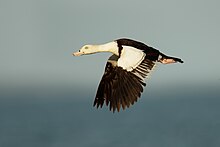Radjah shelduck
| Radjah shelduck | |
|---|---|

| |

| |
| Scientific classification | |
| Domain: | Eukaryota |
| Kingdom: | Animalia |
| Phylum: | Chordata |
| Class: | Aves |
| Order: | Anseriformes |
| Family: | Anatidae |
| Genus: | Radjah Reichenbach, 1853 |
| Species: | R. radjah
|
| Binomial name | |
| Radjah radjah (
Lesson, RP , 1828) | |
| Subspecies | |
|
R. r. radjah (Lesson, RP, 1828) | |
| Synonyms | |
|
Tadorna radjah | |
The radjah shelduck (Radjah radjah), is a
Taxonomy
The specific name radjah is from the Moluccan name Radja for the radjah shelduck on the island of Buru in Indonesia.[2]
Formerly placed in the
Current classification places it in its own monotypic genus Radjah.Description

Both the male and female of the species are mostly white, with dark wing-tips and a distinctive "collar" of dark feathers. When viewed from above, during flight or with wings outstretched, green bands are visible on the tops of their wings. To communicate, the female utters a harsh rattle while the male emits a breathy, "sore-throat" whistle.
Distribution and habitat
The radjah shelduck inhabits the mangrove forests and coastline of
The species prefers the salty waters of
Behaviour
The radjah shelduck forms long-term, bonded pairs, and they are usually encountered in lone pairs or small flocks. During the rainy season, the males commonly become very irritable, and have been observed attacking their mates.
The ducks' preferred diet consists mainly of mollusks, aquatic or other insects, worms, aquatic weeds, sedge materials and algae. Pairs start searching for nesting sites during the months of January and February. They nest close to their primary food source, often in the hollow limbs of dead or dehydrated trees, which makes habitat destruction a particular issue.
The radjah shelduck does not use nesting materials apart from some self-supplied down feathers. Egg-laying is usually completed by May or June, but depends on the extent of the wet season. The clutches range from 6 to 12 eggs. Incubation time is about 30 days.
References
- . Retrieved 12 November 2021.
- ISBN 978-1-4081-2501-4.
External links
- Radjah Shelduck article on the Honolulu Zoo website

